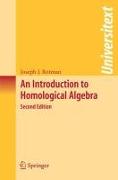An Introduction to Homological Algebra
BücherAngebote / Angebote:
With a wealth of examples as well as abundant applications to Algebra, this is a must-read work: a clearly written, easy-to-follow guide to Homological Algebra. The author provides a treatment of Homological Algebra which approaches the subject in terms of its origins in algebraic topology. In this brand new edition the text has been fully updated and revised throughout and new material on sheaves and abelian categories has been added.
Applications include the following:
* to rings -- Lazard's theorem that flat modules are direct limits of free modules, Hilbert's Syzygy Theorem, Quillen-Suslin's solution of Serre's problem about projectives over polynomial rings, Serre-Auslander-Buchsbaum characterization of regular local rings (and a sketch of unique factorization),
* to groups -- Schur-Zassenhaus, Gaschutz's theorem on outer automorphisms of finite p-groups, Schur multiplier, cotorsion groups,
* to sheaves -- sheaf cohomology, Cech cohomology, discussion of Riemann-Roch Theorem over compact Riemann surfaces.
Learning Homological Algebra is a two-stage affair. Firstly, one must learn the language of Ext and Tor, and what this describes. Secondly, one must be able to compute these things using a separate language: that of spectral sequences. The basic properties of spectral sequences are developed using exact couples. All is done in the context of bicomplexes, for almost all applications of spectral sequences involve indices. Applications include Grothendieck spectral sequences, change of rings, Lyndon-Hochschild-Serre sequence, and theorems of Leray and Cartan computing sheaf cohomology.
Joseph Rotman is Professor Emeritus of Mathematics at the University of Illinois at Urbana-Champaign. He is the author of numerous successful textbooks, including Advanced Modern Algebra (Prentice-Hall 2002), Galois Theory, 2nd Edition (Springer 1998) A First Course in Abstract Algebra (Prentice-Hall 1996), Introduction to the Theory of Groups, 4th Edition (Springer 1995), and Introduction to Algebraic Topology (Springer 1988).
Folgt in ca. 2-3 Arbeitstagen

